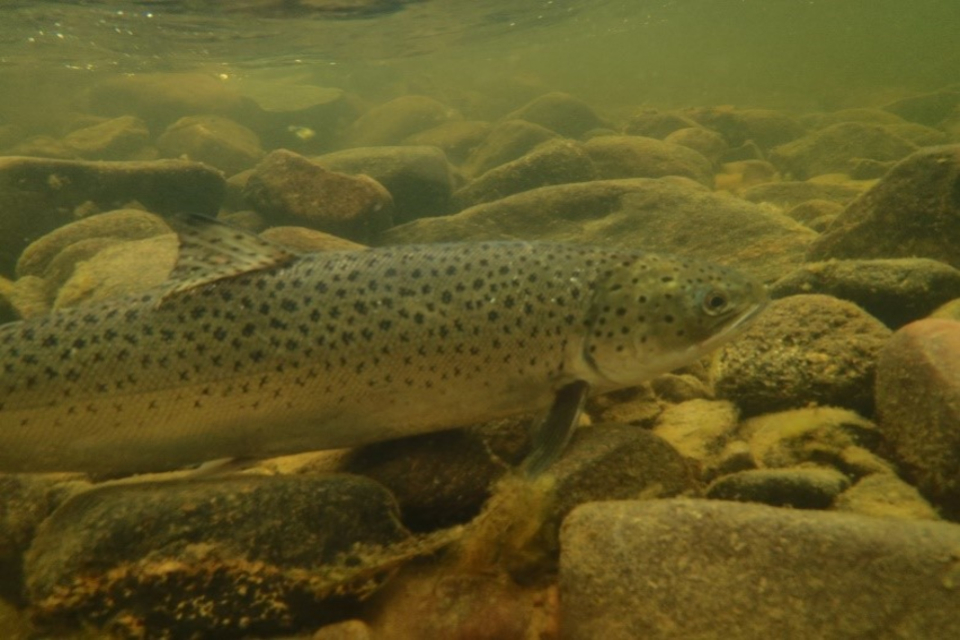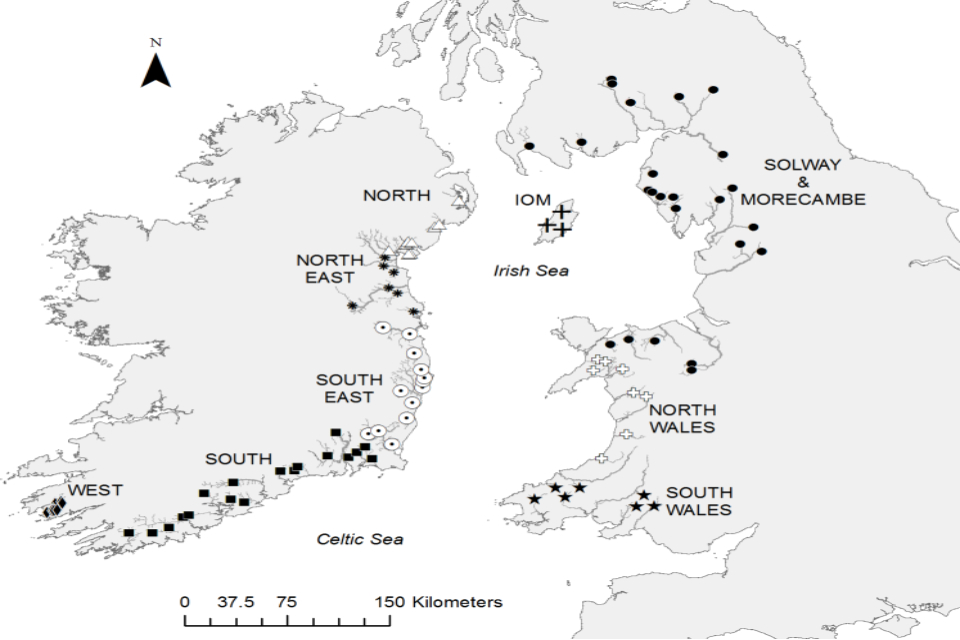Celtic sea trout project - summary
Published 19 February 2019
1. Chief Scientist’s Group research summary
This major international project aimed to learn more about the ecology of sea trout populations around the Irish Sea, in order to improve their conservation and management.
1.1 Background
The sea trout (Figure 1) is the migratory form of the brown trout, Salmo trutta. It occupies freshwater zones for its early life, and coastal zones for the marine phase (for periods of a few months up to 1 or 2 years). The sea trout is a complex animal which requires good environmental quality in freshwater, in estuaries and at sea in order to thrive. Its life history features and widespread occurrence make it a unique and potentially sensitive indicator of environmental change.

Figure 1: Sea trout
Sea trout are important for tourism, the fishing industry and peripheral communities. Their fisheries are at risk from overfishing and from warming waters arising from climate change. In recent years, concerns about the status of sea trout has focused attention on the need for detailed and sustained research, with a major emphasis on its marine phase where it is exposed to a variety of threats and pressures.
1.2 Project aims
The Celtic Sea Trout Project aimed to answer the following key questions:
- Do sea trout populations from different rivers around the Irish Sea coasts vary genetically? If so, how much, and therefore what marine movement and exchange does this indicate?
- How and why does sea trout abundance vary over time and between regions and rivers?
- How do life histories – size and age composition and growth – vary among different fisheries and over time?
- How does the sea trout’s diet vary around the Irish Sea?
- How can this information be assembled to offer better decision-making and management advice using models based on population dynamics and responses to environmental factors (principally climate change)?
1.3 Question 1: Stock structuring
A genetic baseline was established by sampling juvenile trout in nursery streams. This baseline forms the basis for comparison with adult sea trout sampled at sea to allow their river of origin to be determined and, in turn, where they are likely to return to spawn (sea trout are known to home tightly to the river where they were born). Figure 2 shows the river sampling locations.

Figure 2: The Celtic Sea Trout Project study area, showing river sampling locations for the genetic baseline
The study indicated that there were 9 distinct genetic groups of sea trout within the Irish Sea area, though there was evidence of fish moving between populations to breed. This structuring was also broadly supported by analysis of the chemical composition of the fishes’ scales (micro-chemistry), which reflects the unique water environment the fish have grown up in.
Figure 3 shows these genetic groupings.

Figure 3: The nine distinct groups of sea trout populations around the Irish Sea
1.4 Question 2: Variation in abundance in time and space
This work was based on the long-term spatial and temporal variation in rod catch data. Despite variable data quality, it was possible to show that changes in sea trout abundance over time – as indicated by catches – tracked closely amongst regions and countries (eastern Ireland, Wales, south-west Scotland and north-west England).
This finding points to common factors acting on catches and possibly stocks. Between-river variations in abundance were large, and river size and fishing effort are important factors governing this. However, studies of the environmental characteristics of the catchments of Irish Sea rivers showed that sea-trout fishery status is strongly associated with chemical productivity of the water and land cover type. Smaller rivers with low alkalinity, higher forest cover and less intensive land usage tend to be better sea trout rivers.
1.5 Question 3: Life histories, growth and stock structure
The information used to answer this question came from the extensive scale readings obtained during the Celtic Sea Trout Project, coupled with measurements of fish size. Scale reading can reveal fish age at capture, age at seaward migration, its growth rate in different years and its previous breeding schedule. A broad pattern emerged of:
- faster growth and higher survival (more multi-year spawners) in the south Wales sector
- high survival, but somewhat slower growth in the north-east sector of the study region (Cumbria and Galloway)
- lower survival off the Irish coast, where finnock (fish returning to the river in the same year that they migrated out to sea from it) dominated the runs in most rivers
The Lough Currane catchment in south-west Ireland was a major exception, with a high proportion of long-lived adult sea trout.
An unexpected result was the high degree to which sea trout continued to feed and grow during winter months at sea. A strong influence of water temperature is evident with faster growers in the warmer areas.
There is evidence of longer term trends in stock composition in some rivers such as the Afon Conwy in north Wales, with a large decline in abundance of large sea trout. This was in contrast with the increased numbers in the rivers flowing into Cardigan Bay in west Wales. This corresponded with an increase in the abundance (and proportion) of smaller sea trout and indicates sub regional scale influences on the time of first return from the sea and/or on survival.
1.6 Question 4: Feeding
One of the advantages of the trout’s seaward migration compared to freshwater residency is access to a high fat content, fish diet. Sand eels and sprat were found to be the dominant prey items, with a much smaller proportion of crustaceans and worms (Figure 4). There also appear to be differences in diet composition between different regions of the Irish Sea with a greater proportion of sprat in the diets of trout from the north-eastern Irish Sea, and a diet dominated by sandeel along the Irish coast.
Because of its link with sea trout growth, prey abundance might be expected to affect the abundance of sea trout. However, the abundance of sea trout prey species in the Irish Sea is not monitored regularly and so remains a gap in our understanding.

Figure 4: Cumulative percentages of weight of prey items by sea trout size category (fish length in 50mm increments)
1.7 Question 5: How to offer better management advice for sea trout stocks
Management recommendations included the following:
- A standardised comprehensive approach to recording catch data in sea trout fisheries throughout the Irish Sea would make management and monitoring easier.
- The potential for sea trout from different rivers to be caught in fisheries operating in coastal waters in most areas of the Irish Sea suggests that some of these are mixed stock fisheries, potentially exploiting a number of distinctive and unique stocks. Further research is needed to provide quantitative, specific advice to develop local conservation plans for sea trout.
- Smaller, nutrient-poor rivers with less intensively farmed catchments and fewer barriers to migration to easily accessible spawning grounds are more likely to be prolific sea trout rivers. Management action to enhance sea trout stocks in the Irish Sea should focus on such rivers, striving to maintain as far as practicable their relatively pristine state.
- There is considerable potential for freshwater production of sea trout in many small coastal streams not specifically assessed in the Celtic Sea Trout Project. Such streams should form part of wide scale conservation plans for their freshwater and marine habitats.
- Life history modelling indicated great variation in the population dynamics of different stocks. For example, those in south Wales have higher survival and growth rates, and thus greater resilience to environmental pressures. Plans for the management of the exploitation of these stocks need to take account of these widely differing dynamics.
- A more robust and long-term protocol for sea trout scale collection and analysis is needed to make the method suitable for scientific assessment.
- Better monitoring of the prey species of sea trout may be essential for better modelling of population trends and future management.
- For sea trout, the sea is shown to be a highly structured and dynamic habitat, exerting a strong influence on population dynamics. The future of sea trout stocks depends as much on understanding and protecting the marine environment as on protecting freshwaters.
- Sea trout are vulnerable to human activities in the sea. The increasing use of coastal waters of the Irish Sea for a wide range of activities such as shipping, aggregate extraction, fisheries for marine species and renewable energy infrastructure, presents a potential threat. Marine spatial planning and the implementation of the EU Marine Strategy Framework Directive offer routes for integrated environmental protection that could benefit sea trout and there needs to be greater recognition of the species in these systems.
Figures 2, 3 and 4 are reproduced from the main report with the editors’ permission.
1.8 Publishing details
This summary relates to information from project SC080037, reported in detail in the following output:
Title:
MILNER, N., MCGINNITY, P. AND ROCHE, W. (ed.), 2016. Celtic Sea Trout Project. Technical report to Ireland Wales Territorial Co-operation Programme 2007–2013 (INTERREG 4A) [online]. Dublin: Inland Fisheries Ireland. Available from here
May 2018
Project manager:
Dr Jonathan King, University of Bangor
Editorial committee:
Nigel Milner, Philip McGinnity and William Roche
Research Contractor:
The project was delivered principally through the Ireland–Wales Cross-Border partnership; work was carried around the Irish Sea in a multi-partner collaboration. Participants were Bangor University, Inland Fisheries Ireland, University College Cork, Environment Agency Wales (now Natural Resources Wales), Environment Agency (England), Isle of Man Government, Nith District Salmon Fisheries Board, Galloway Fisheries Trust, Annan District Salmon Fisheries Board and Buccleuch Estate (Border Esk). Subcontractors included APEM Ltd, Cefas and Fishskill.
This project was part-funded under the Ireland Wales Territorial Co-operation Programme 2007–2013 (INTERREG 4A). Additional funding was provided by Environment Agency Wales (now Natural Resources Wales), Environment Agency (Evidence Directorate), River Annan District Salmon Fishery Board, Nith District Salmon Fishery Board and the Galloway Fisheries Trust.
Enquiries: research@environment-agency.gov.uk
© Environment Agency

